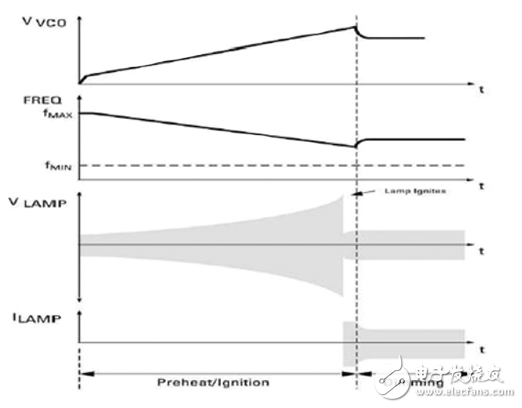
资料下载

节能灯需要独特的驱动电压,测序,并注意EMI、PFC、缺点
节能灯需要独特的驱动电压,测序,并注意EMI、PFC、缺点
紧凑型荧光灯泡(CFL)是照明领域德高望重的白炽灯泡的节能替代:将输入的电能输出的可见光约百分之25,相比百分之5的传统灯泡(五的一个因素的改进)。然而,不像白炽灯泡,可以从AC或直流工作在一个广泛的电压水平(取决于设计和施工细节),或LED,这需要一个调节直流电流源为20至50 mA,CFL需要更复杂的启动和工作电压序列。
此外,还有其他挑战的CFL的复杂驱动电路。它必须符合规定的EMI排放量,提供功率因数校正(PFC),并处理故障模式在CFL灯泡本身,所有这些都使驾驶CFL一个复杂的问题。最后,如果有需要昏暗的灯,这是经常发生的情况,驱动电路必须实现调光在一个具有成本效益的和愉快的方式,相当于低成本的可控硅调光的白炽灯泡。所有必要的CFL电路,称为镇流器,必须包装成一个住房在灯泡的基础上,形成一个标准的爱迪生式螺旋灯座灯。术语说明:灯泡是玻璃外壳;灯泡是灯泡加电路和基础单元,但术语经常互换使用。

CFL voltages and timing
In a CFL, electrons from a heated filament flow through the bulb and collide with mercury atoms in the tube. As a result of these collisions, photos are released, but they are in the UV wavelength range and thus not useful for illumination. To convert UV to visible light, the inside of the fluorescent tube is coated with a phosphor. As the emitted UV photons hit this phosphor, the coating glows and gives off the visible light of the bulb.
Sounds simple enough, but unlike the incandescent and LED bulbs which operate from a steady-state power rail, the CFL voltage is a sequence of three voltage phases (Figure 1)。 In the pre-ignition phase, the lamp needs a current to pre-heat its filaments. Next, the bulb needs a high-voltage DC level for ignition, followed by a high-frequency AC signal during the actual running (illumination) phase.
声明:本文内容及配图由入驻作者撰写或者入驻合作网站授权转载。文章观点仅代表作者本人,不代表电子发烧友网立场。文章及其配图仅供工程师学习之用,如有内容侵权或者其他违规问题,请联系本站处理。 举报投诉
- 相关下载
- 相关文章








